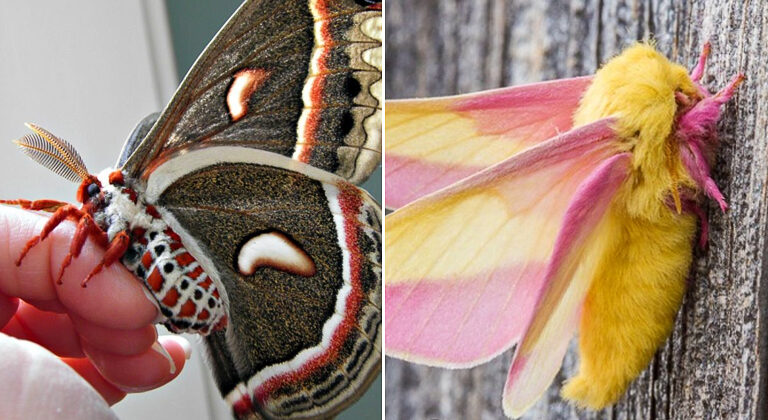There are around 160,000 unique moth species, and very often we tend to get carried away by the generalized idea that moths are pests and look scary, rather than a really beautiful creature full of wonderful characteristics. Some species have truly vibrant colours and shapes that rival those of butterflies.
Here are 20 of the most beautiful moths species from around the world.
1. Elephant hawk moth
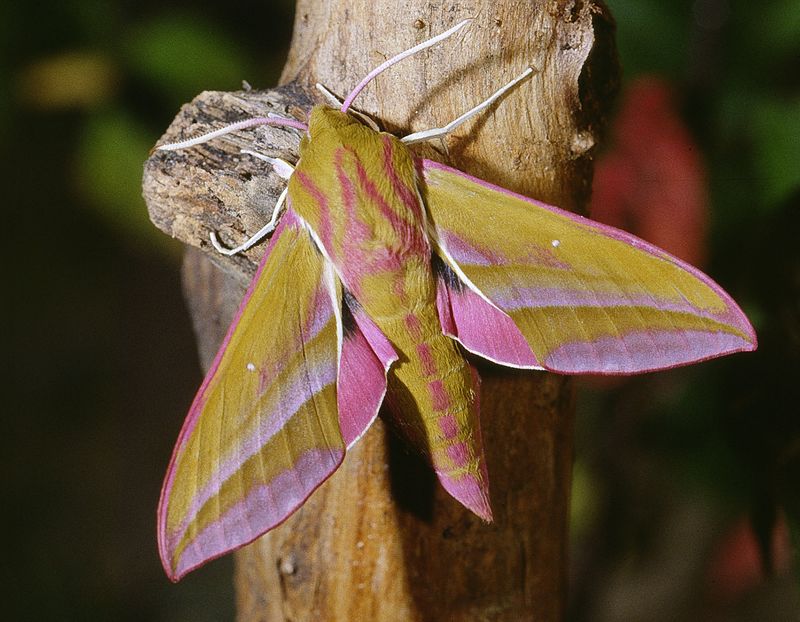
The elephant hawk moth or large elephant hawk moth (Deilephila elpenor). Its common name is derived from the caterpillar’s resemblance to an elephant’s trunk. It is most common in central Europe and is distributed throughout the Palearctic region. Its distinct olive and pink coloring makes it one of the most recognizable moths in its range. However, it is quite easy to confuse the elephant hawk moth with the small elephant hawk moth, a closely related species that also shares the characteristic colors. The elephant hawk moth has very sensitive eyes that allow it to see color even at low-light, and it was one of the first species in which nocturnal color vision was documented in animals.
2. Giant leopard moth
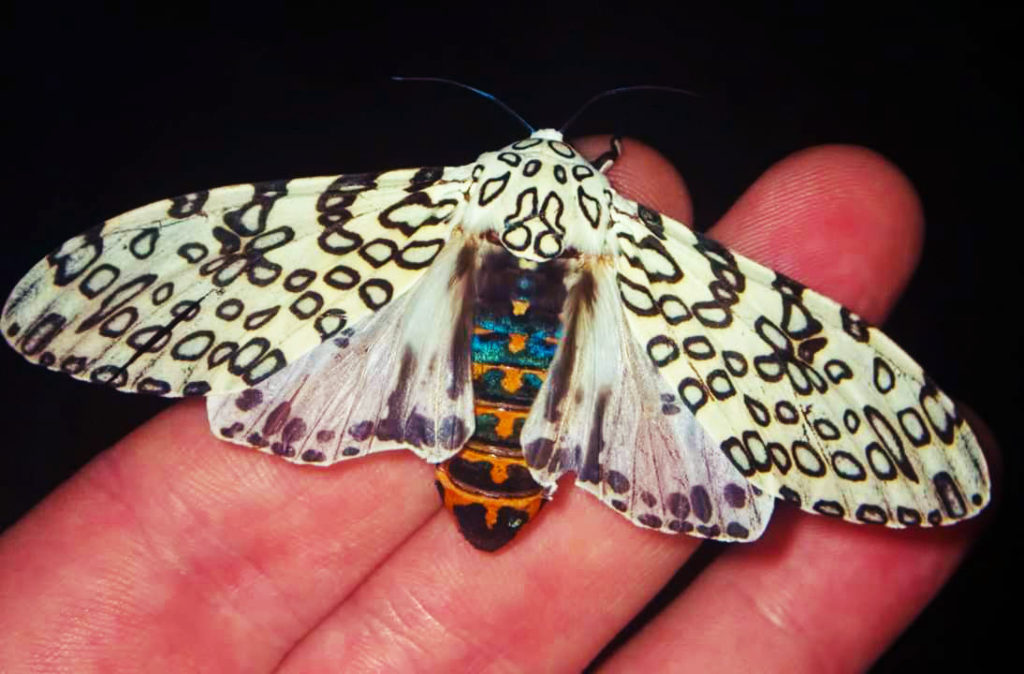
The giant leopard moth (Hypercompe scribonia) is a moth of the family Erebidae. They are distributed through North America from southern Ontario, and southern and eastern United States through New England, Mexico and down to Panama. This species has a wingspan of 76 mm (3 in). The wings of this moth are bright white with a pattern of neat black blotches, some solid and some hollow. The overside of the abdomen is dark blue with orange markings, while the underside is white with solid black spots, and males have a narrow yellow line on the sides. Their legs have black and white bands. Adult moths are strictly nocturnal and do not generally fly before nightfall.
3. Cecropia moth
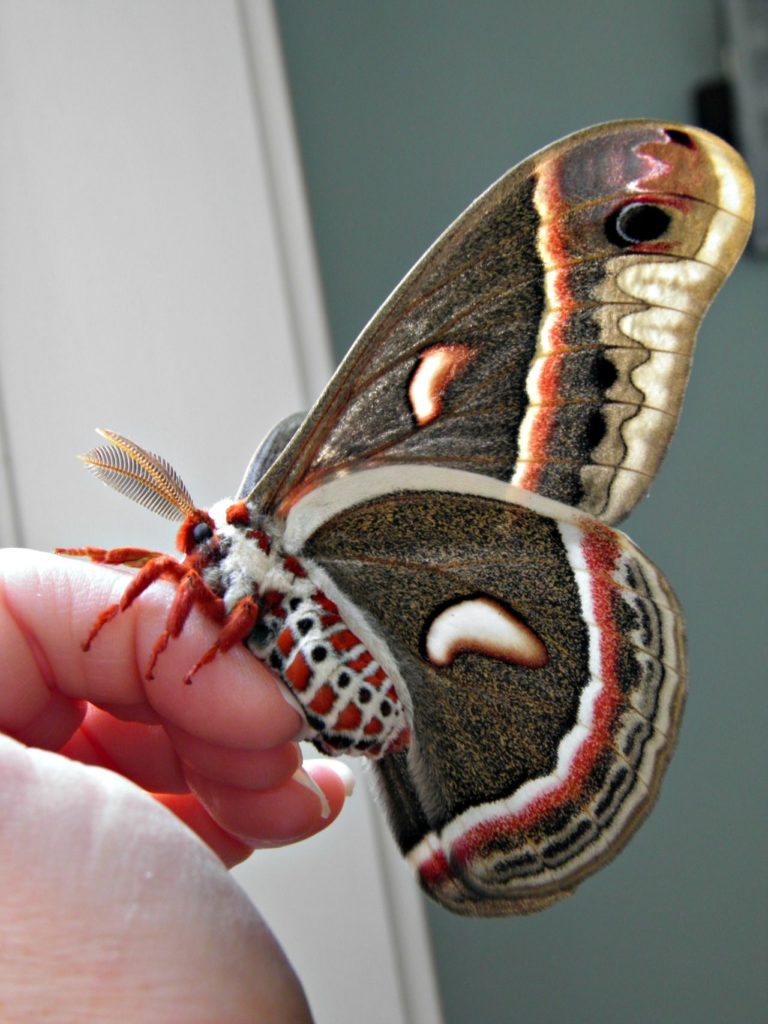
Hyalophora cecropia, the cecropia moth, is North America’s largest native moth. It is a member of the family Saturniidae, or giant silk moths. Females have been documented with a wingspan of five to seven inches (160 mm) or more. These moths can be found all across North America as far west as Washington and north into the majority of Canadian provinces. Cecropia moth larvae are most commonly found on maple trees, but they have also been found on cherry and birch trees among many others. The species was first described by Carl Linnaeus in his 1758 10th edition of Systema Naturae.
4. Coffee clearwing moth
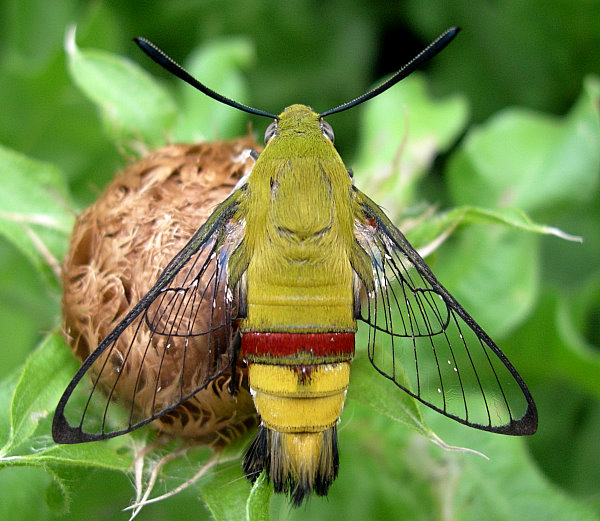
Cephonodes hylas, the coffee bee hawkmoth, pellucid hawk moth or coffee clearwing, is a moth of the family Sphingidae. The species was first described by Carl Linnaeus in 1771. A widely distributed moth, it is found in the Near East, Middle East, Africa, India, Sri Lanka, Japan, Southeast Asia and Australia. It has transparent wings and a stout body like a bumble bee. Its wingspan of 45–73 mm. Its marginal borders are very narrow and black. Abdomen varies in colour from yellow to green. Nominate subspecies has bright reddish 3rd and 4th abdominal segments.
5. Comet moth
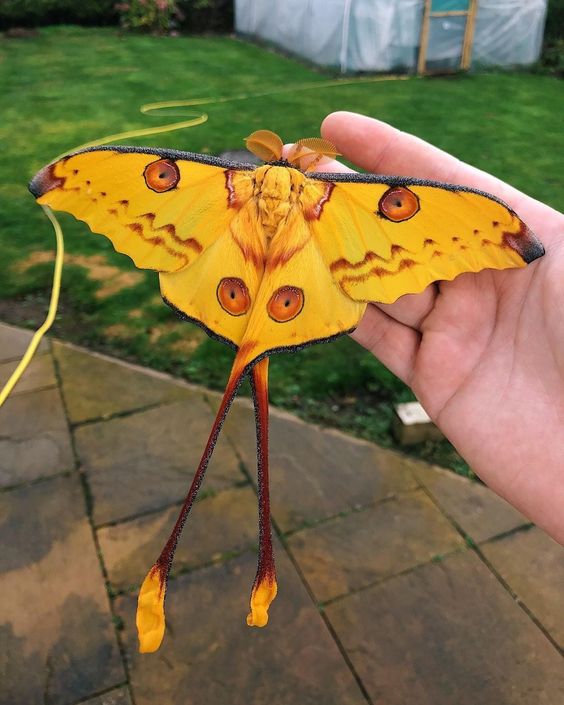
The comet moth or Madagascan moon moth (Argema mittrei) is a moth native to the rain forests of Madagascar. The species was first described by Félix Édouard Guérin-Méneville in 1847. The male has a wingspan of 20 cm (7.9 inches) and a tail span of 15 cm (5.9 inches), making it one of the world’s largest silk moths. The female lays from 120 to 170 eggs, and after hatching, the larvae feed on Eugenia and Weinmannia leaves for approximately two months before pupating. The cocoon has numerous holes to keep the pupa from drowning in the daily rains of its natural habitat. The adult moth cannot feed and only lives for 4 to 5 days. Although endangered in the wild due to habitat loss, the comet moth has been bred in captivity.
6. Emperor moth
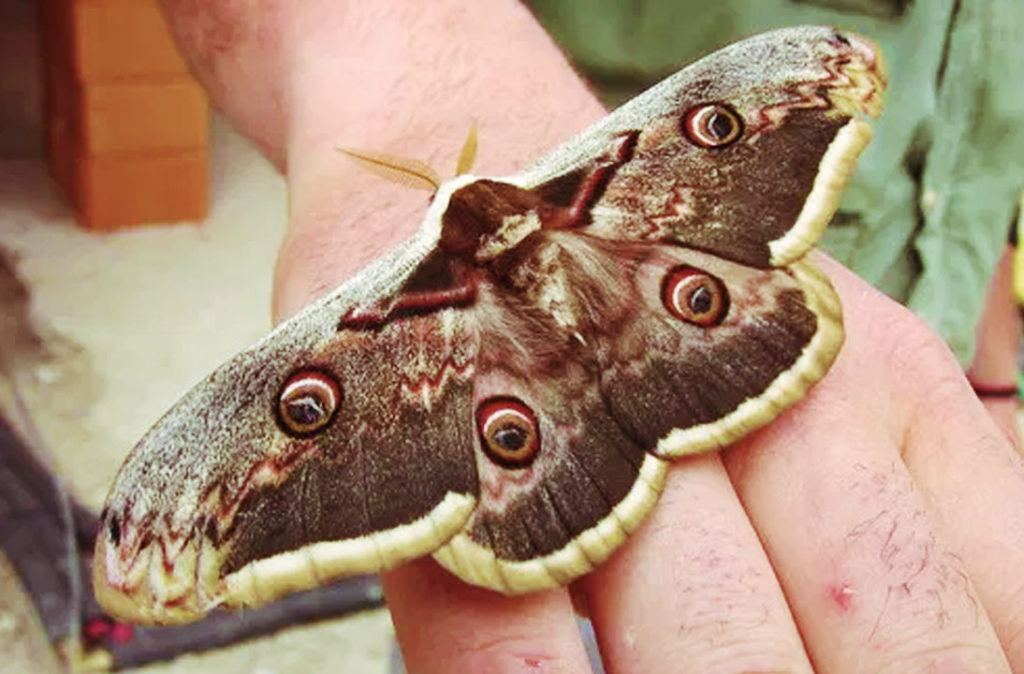
The Emperor moth is a widespread, but never very common, moth of heathland, moorland, woodland rides, sand dunes and grassland scrub. A very large moth, the female can have a wingspan of up to 10cm, but the male is smaller, with large, feathery antennae. During the day, males can be seen flying swiftly about and can be mistaken for butterflies. The females rest in low vegetation during the day, releasing a special scent to attract males. The caterpillars feed on woody plants, such as heather, bramble and blackthorn, and overwinter as chrysalides, sometimes for two winters.
7. Galium sphinx moth
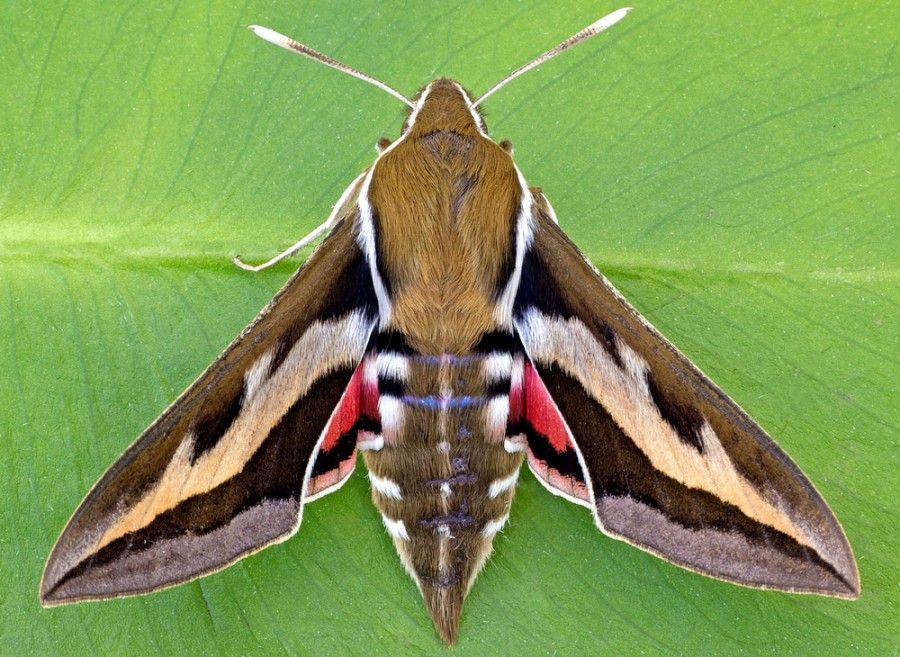
The gallium sphinx moth is also known as the bedstraw hawk moth. Many gardeners are familiar with the larval stage of the tomato hornworm, also a member of the hawk moth/sphinx moth/hornworm (most sphinx moth caterpillars have a “horn” on the end of their body) family. The moths in this family are often fairly large, and are known for their rapid, sustained flying ability. Some species of hawk moths can fly as fast as 30 miles per hour. Some, including the gallium sphinx moth, are able to hover in midair while they feed on nectar from flowers (milkweed flowers in this photograph). This hovering ability is thought to have evolved only three times in nectar feeders – in hummingbirds, certain bats and hawk moths.
8. Garden tiger moth
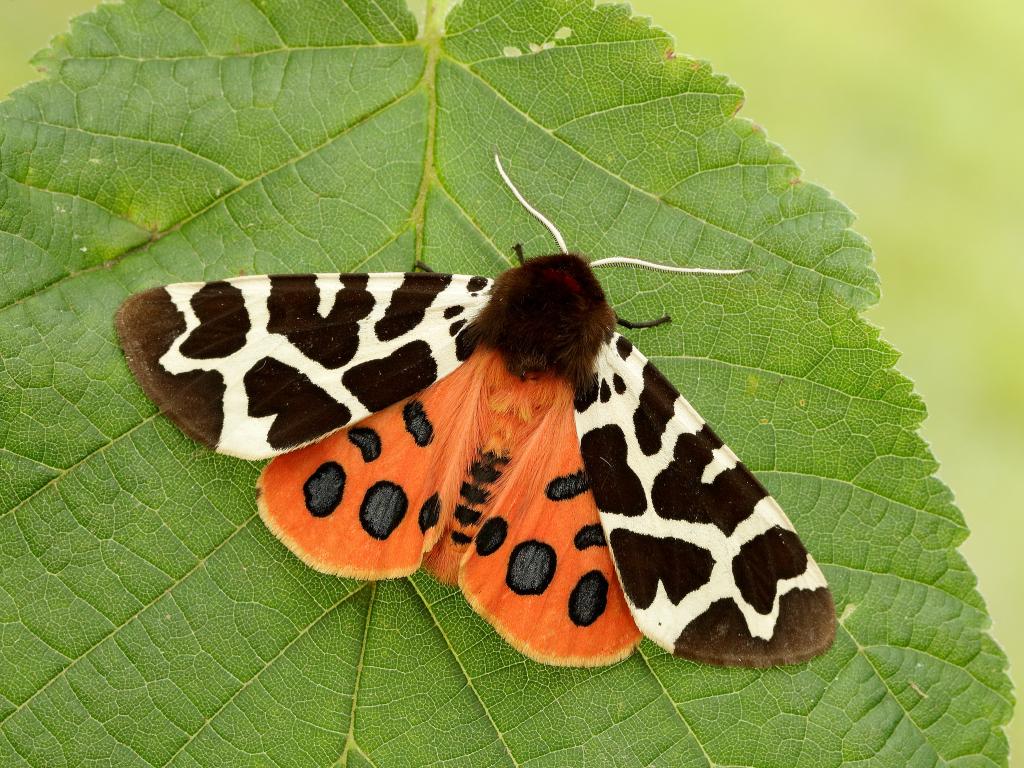
The Garden Tiger Moth is a dramatically colourful species found throughout much of the British Isles, Northern Europe, North America and Northern Asia. In the British Isles it occurs commonly in gardens and open countryside although in recent years numbers have declined alarmingly. The image shown below left of six Garden Tigers attracted to light in a Cornish garden is becoming an increasingly rare sight these days. The caterpillars feed on a wide variety of low growing herbaceous plants such as dandelion, dock and plantain. When feeling threatened the moth opens its wings and displays bold red hindwings with dark blue spots as a warning that it is distasteful. Should a predator attack then it secretes a yellowy fluid from a gland behind its head.
9. Hercules moth
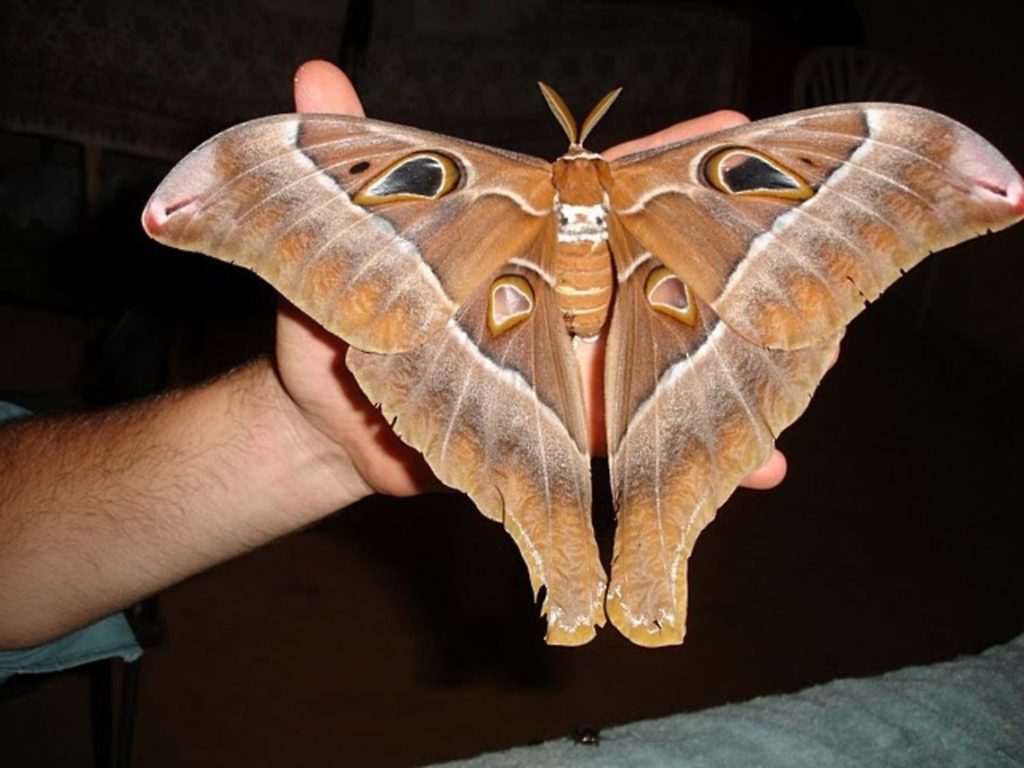
The Hercules moth (Coscinocera hercules) might not have super strength and a history of heroic deeds, but it does grow to an astonishing size. Adult female Hercules moths have a wingspan of around 27cm, consistently charting as one of the world’s biggest species of moth. The largest Hercules female ever found was reported to have reached 36cm. Males are more lightly built and have long tails on the hindwings. They are native to the rainforests of northern Queensland and New Guinea. Despite reaching a gargantuan size, these adult moths don’t get a lot of time to frolic around in the trees. Living up to two weeks (and longer than one night if the males are very lucky), as soon as they emerge from their cocoons, it’s business time. Without mouths, these moths are not distracted by pesky necessities such as feeding. Instead, the female gets to work releasing a potent airborne perfume (pheromone) that attracts males from a distance. Detecting her advertisement, he flies to find the waiting female, mates, and his story is over.
10. Io moth

Automeris io, the Io moth, is native to the Nearctic region. It is found throughout the eastern half of the United States, as far west as Utah, Colorado, and Texas. Its range extends as far north as Quebec, Ontario, and southern Manitoba. It is also found in eastern Mexico and Costa Rica, in the northernmost portion of the Neotropical region. The attractive Io moth caterpillar is also well-known because of its painful sting.
11. Japanese silk moth
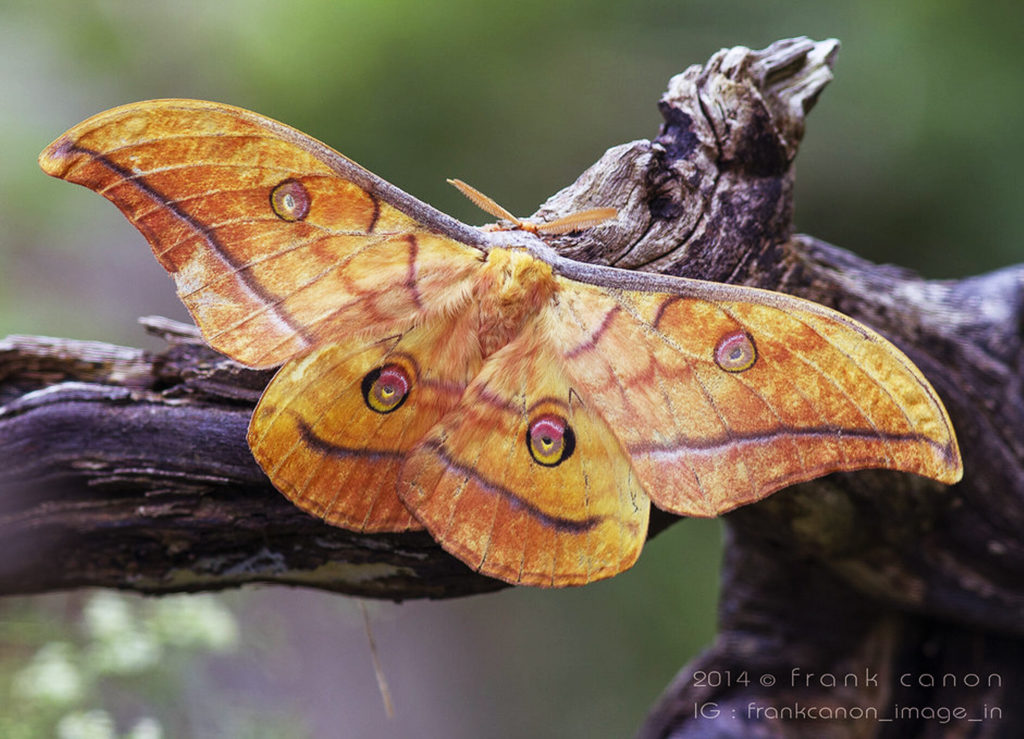
The Japanese Silk Moth or Japanese Oak Silkmoth (Antheraea yamamai, Japanese: Yamamayu[ga]) is a moth of the Saturniidae family. It is endemic to Japan, but has been imported to Europe for silk production and is now found in South-Eastern Europe, mainly in Austria, North-Eastern Italy and the Balkan. It seems to be spreading north and a population near Deggendorf and Passau (Bayern) has been reported. It has been hybridized artificially with Antheraea polyphemus of North America. This moth has been cultivated in Japan for more than 1000 years. It produces a naturally white silk that is very strong and elastic, but does not dye well. It is now very rare and expensive. The wingspan is 110–150 millimetres (4.3–5.9 in). Adults are on wing from August to September in one generation depending on the location.
12. Lime hawk moth
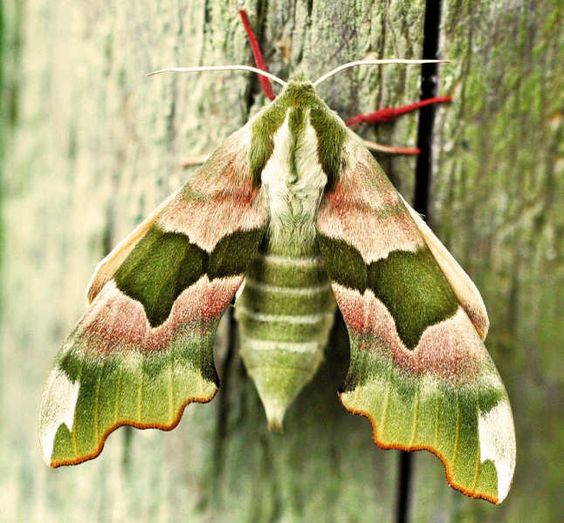
Mimas tiliae, the lime hawk-moth, is a moth of the family Sphingidae. It is found throughout the Palearctic region and the Near East, and has also been identified in eastern Canada. The wing shape, markings and pink and green colour are unlike those of any other Hawk-moth found in the UK. Adults can be seen between May and early July. Often comes to light, but does not feed. Can be found at rest on walls, tree trunks and lime foliage. The wingspan is 70–80 millimetres (2.8–3.1 in). It exhibits sexual dimorphism, the male usually being smaller but more strongly marked than the female. Usually, the forewing ground colour is brownish in females and decidedly green in males, but there are many exceptions. The female abdomen is straight and fat with fully formed eggs, which are already present when the female emerges (as in all species of Smerinthini). The male abdomen, on the other hand, is strongly curved and slender.
13. Madagascan sunset
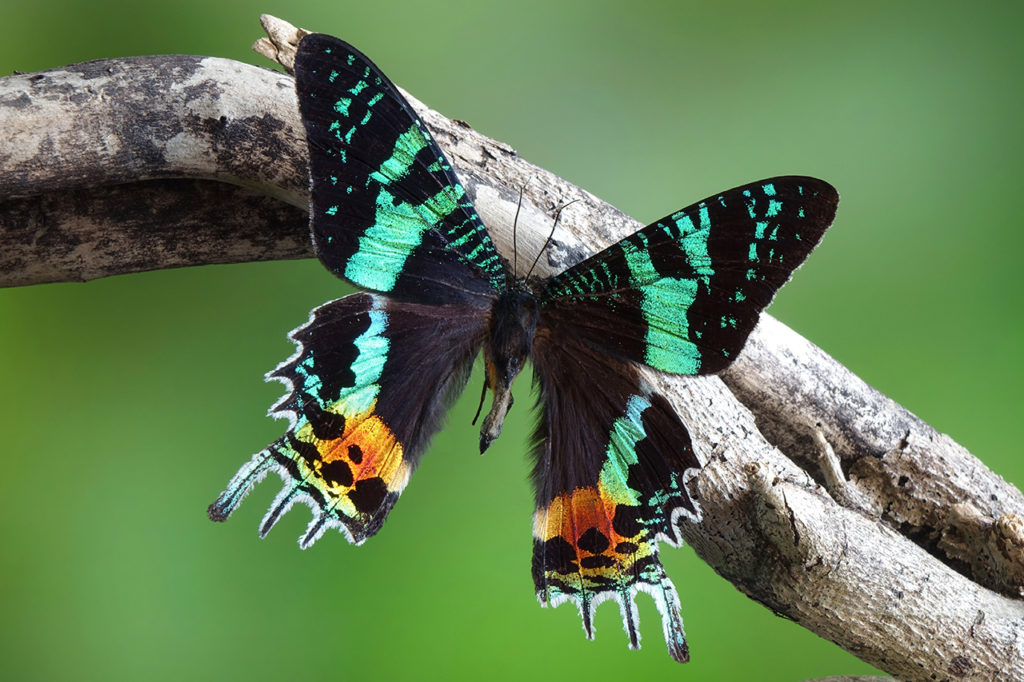
The Madagascan Sunset Moth is a brightly colored day-flying moth native only to the island of Madagascar.
The moth’s wings are iridescent and appear in shades of black, red, green, and blue. However, much of the moth’s wings contain no pigment at all. The flashy colors are created by the curvature of the scales on their wings that reflect light in different angles, giving the appearance of color. The Madagascan Sunset Moth is toxic to most predators, and its colorful wings may actually serve as a warning to predators to leave them alone.
14. Rosy maple moth
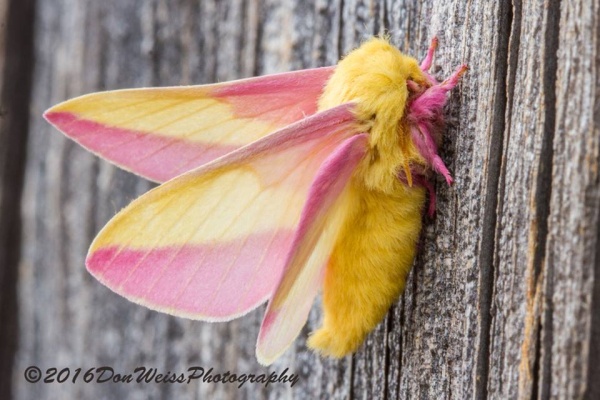
The rosy maple moth (Dryocampa rubicunda) is a silk moth in the family Saturniidae. Found throughout North America, this moth is not generally considered a pest, though its caterpillars have proven to be a nuisance to various maple tree species. The rosy maple moth can be identified by its vivid colors. It is found in various hues, including creams, whites, pinks, yellows, and purples. However, the pink and yellow variation seems to be the most common. The adult moth is thick and fuzzy, with males displaying long, comblike antennae that allow them to detect the airborne chemicals (pheromones) that females give off to attract mates. Regardless of sex, the rosy maple moth is considered the smallest of the silk moths– adults are up to 2 inches across when wings are spread, and males are smaller than females.
15. Rothschildia aurota
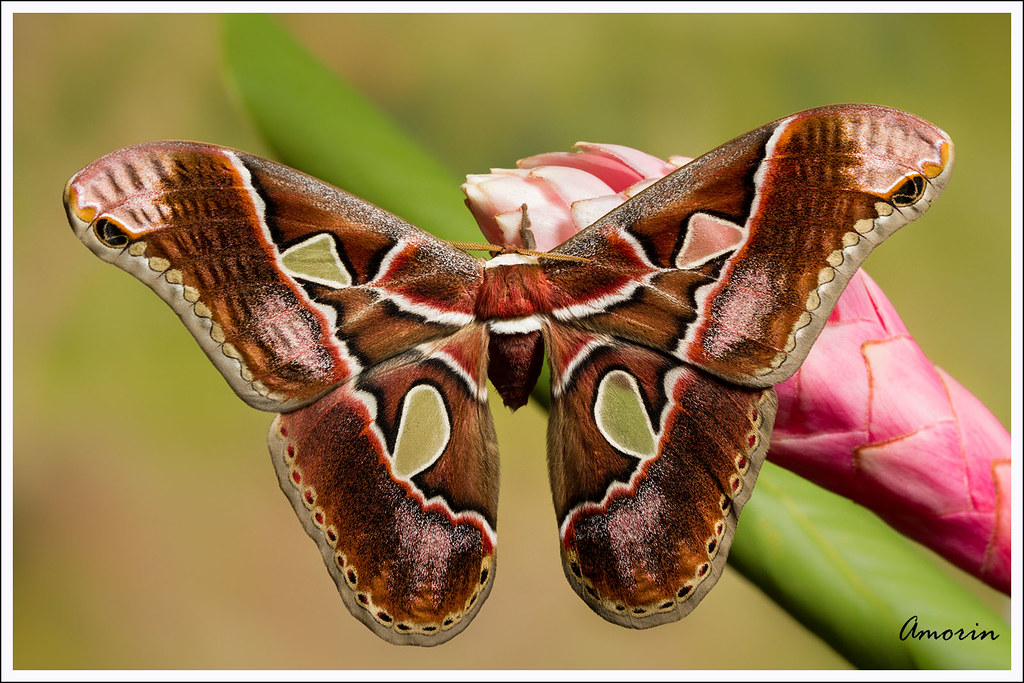
Rotschildia aurota is one of the biggest silkmoths you can encounter in South America, and one of the many species of moths from the genus Rothschildia. It can be considered an Amazonian species; most records of them are in the eastern Andes and covering the Amazon basin. The largest of them have wingspans of around 150mm-170mm, although most specimens you encounter will be smaller. The males are smaller than the females too. Specimens produced in captivity by captive breeding them tend to be smaller than their wild counterparts. They can be found in large parts of South America – they have been reported in Peru, Venezuela, Ecuador, Colombia, Bolivia, Guyane, French Guyane, Brazil, Paraguay, Uruguay, Argentinia and possibly more places. The moths seem to fly at higher elevations, although this seems to vary a lot depending on their country of origin; they are generally encountered between 1000m and 3000m.
16. Twin-Spotted Sphinx

The Twin-spotted Sphinx (Smerinthus jamaicensis) is a moth of the Sphingidae family. It is widely distributed across North America and is found everywhere except in the southern half of western California. It has been taken as far north as the Yukon. It has a wingspan of 1+3⁄4–3+1⁄4 inches (4.5–8.3 cm), with the outer margins of the forewings unevenly scalloped, but with the coastal margin of the hindwings being almost straight. Males have gray with black and white markings on their forewings, while females are yellowish brown with dark brown and white markings. Both sexes have red hindwings with a pale yellow border. Sometimes a blue patch may appear as a single eyespot or it may be divided by black bands, creating two or three eyespots. Adult moths are nocturnal, but seem to prefer the earlier part hours of the night.
17. White-lined sphinx
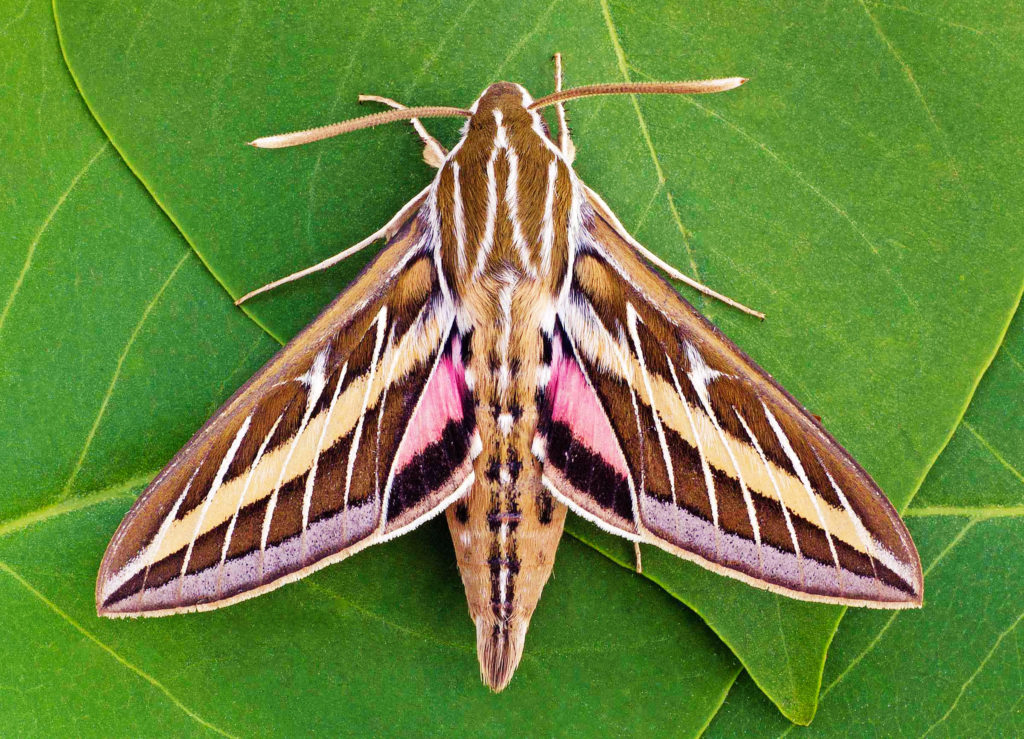
Hyles lineata, also known as the white-lined sphinx, is a moth of the family Sphingidae. They are sometimes erroneously referred to as the hummingbird moth because of their bird-like size (2-3 inch wingspan) and flight patterns. As caterpillars, they have a wide range of color phenotypes but show consistent adult coloration. With a wide geographic range throughout Central and North America, H. lineata is known to feed on many different host plants as caterpillars and pollinate a variety of flowers as adults. Larvae are powerful eaters and are known to form massive groupings capable of damaging crops and gardens. As adults, they use both visual and olfactory perception to locate plants from which they collect nectar.
18. Oleander hawk moth
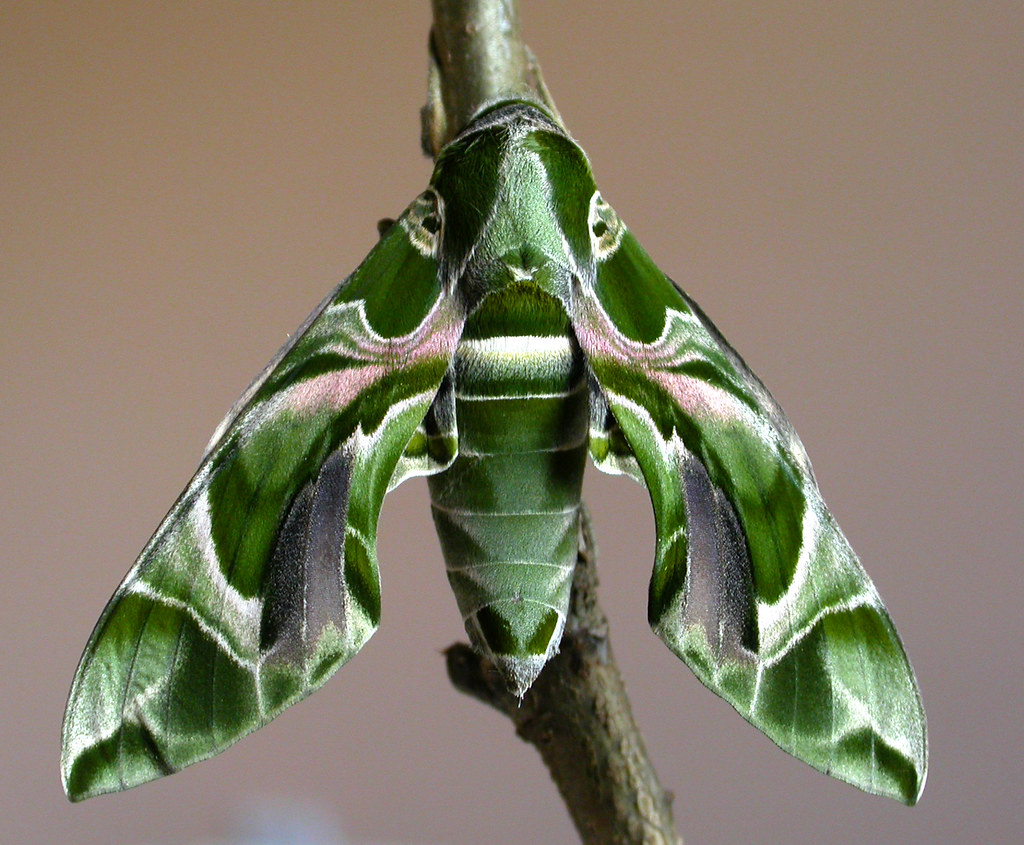
The Oleander Hawk Moth is a large, sleek moth that thrives in warm climates and hides among dense lush green foliage. Native to Asia, Africa, and parts of Europe, the Oleander Hawk Moth arrived in Hawaii in the 1970’s. This member of the Sphinx Moth family is large like its cousins. An adult’s wingspan can stretch to almost 10cm (4 inches). The wings are a collage of green colors ranging from light green to olive to dark forest green. This patchwork of green resembles camouflage fatigues issued in the military. For this reason, the Oleander Hawk Moth is also called an Army Green Moth.
19. False tiger moth
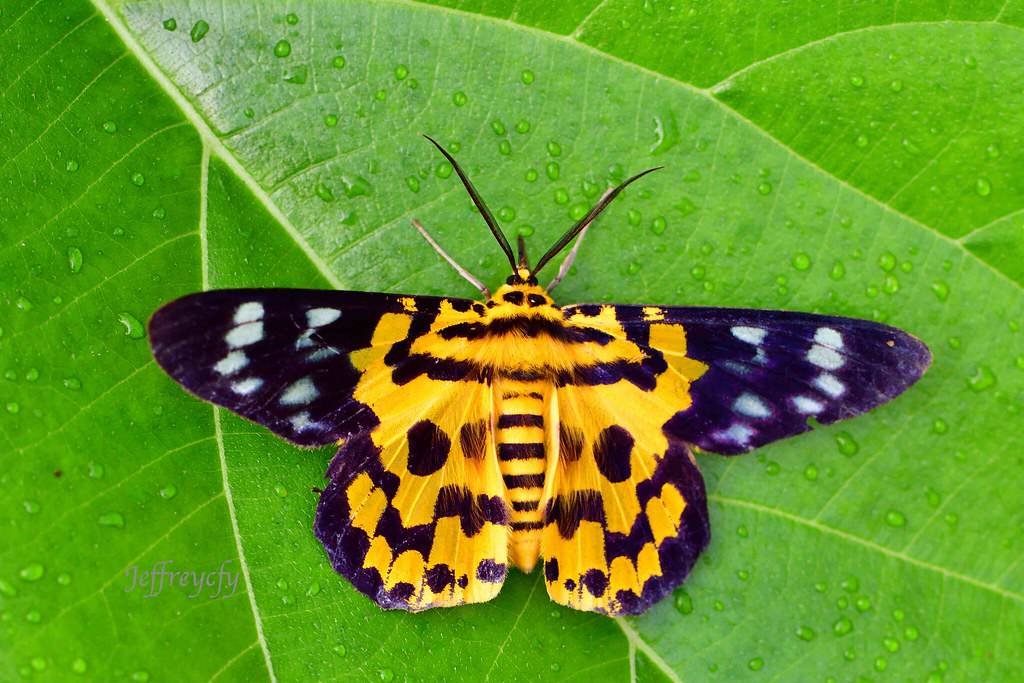
Dysphania militaris is a species of moth of the family Geometridae that is found from in the tropical regions of South and Southeast Asian countries such as China, India, Myanmar, Andaman Islands, Sumatra and Java. It was first described by Carl Linnaeus in his 1758 10th edition of Systema Naturae. Its wingspan is about 80–96 mm. Forewings of male produced, long and narrow. It flies during the day and because of its bright colours it is often mistaken for a butterfly. Several similar species, including Dysphania subrepleta, occur in the region and some are very closely related. Dysphania alloides, which was described from the Andaman Islands, was originally considered a subspecies.
20. Luna moth
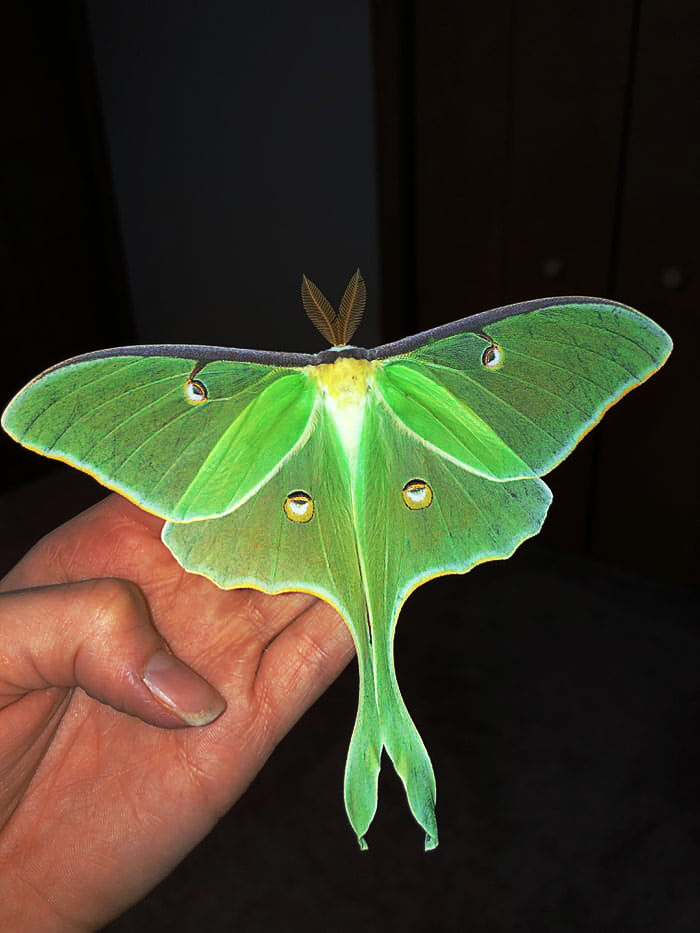
The Luna moth (Actias luna) is a Nearctic moth in the family Saturniidae, subfamily Saturniinae, a group commonly known as giant silk moths. It has lime-green colored wings and a white body. The larvae (caterpillars) are also green. Typically, it has a wingspan of roughly 114 mm (4.5 in), but can exceed 178 mm (7.0 in), making it one of the larger moths in North America. Across Canada, it has one generation per year, with the winged adults appearing in late May or early June, whereas farther south it will have two or even three generations per year, the first appearance as early as March in southern parts of the United States. As defense mechanisms, larvae emit clicks as a warning and also regurgitate intestinal contents, confirmed as having a deterrent effect on a variety of predators. The elongated tails of the hindwings are thought to confuse the echolocation detection used by predatory bats. A parasitic fly deliberately introduced to North America to be a biological control for the invasive species gypsy moth appears to have had a negative impact on Luna moths and other native moths.
Read more articles:
- Silent Killers of the Sea: Fishing Nets and the Devastating Impact on Our Oceans
- Amazing Ability of Sharks to Regrow Their Dorsal Fins
- Mountain Marvels: 7 Architectural Wonders Built into Nature’s Slopes
- The Frilled Shark: Jaws of the Abyss and a Living Fossil
- 30 Christmas Rock Painting Ideas – Last minute DIY crafts for Christmas decor, gifts and stocking fillers

